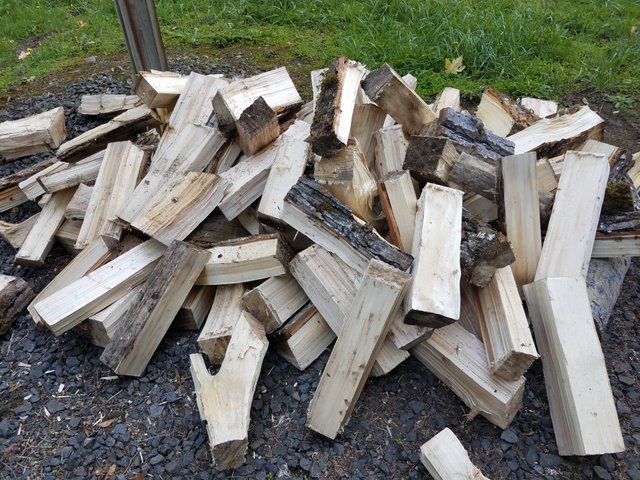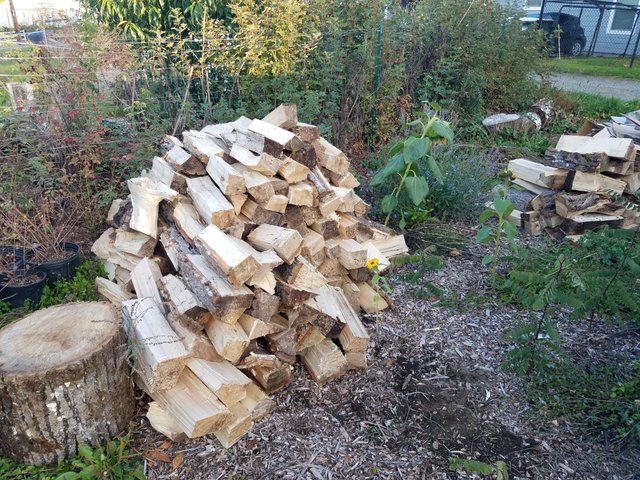Wild Tip: Why I'm Always Collecting Woody Debris

People often find it odd that I collect wood--especially the rotten type. I love getting a good supply of rotten wood. But I'm happy with fresh wood too like the full truck load of black cottonwood I got today. And no I don't collect the wood for burning. So why would I want to collect woody debris?
In my opinion if you don't have a source of woody debris on your wild homestead then finding a source of woody debris is key to having an abundance of life.
So why?
Mimicking a Natural Forest
If you read permaculture related blogs and books or watch related videos then you likely have heard about the productivity of a forest.
This is the basic idea behind a food forest which is basically a designed forest focused on production of food, timber, fiber, medicine, etc. for human use.
But if you look at a natural old growth forest there is one layer that is often ignored even by the experts.
That is woody debris. From snags to logs to the small branches--a forest is filled with dead and decaying wood.
And that is a good thing!
When I bring woody debris onto my wild homestead I do so in order to mimic a natural forest.
The black cottonwood I got today will be used to create several new hugelkultur beds. Hugelkultur beds are basically wood covered in soil that are used to grow plants.
Hugelkultur beds mimic what happens natural in nature with nurse logs. These are logs that fall on the ground, decompose and get buried in leaf litter until trees like western Hemlock can grow out of the logs or alongside them.
The logs nurse these new trees by providing a slow release of nutrients and keep the ground moist. Plus, the nurse logs support lots of beneficial fungi which help the new plants grow by connecting them to a fungal network often called the wood wide web.
A hugelkultur bed mimics a nurse log but speeds up the process by burying the wood. Plus, this is a great way to add more carbon into the ground which helps build soil and mitigate climate change.
Creating Habitat with Wood
But I also use woody debris to create habitat for wildlife on my wild homestead. I have installed a number of logs as snags--standing dead trees--in my growing areas.
Just the other day I saw a nuthatch fly over to one of my snags and hide a sunflower seed under the bark for the winter.
Birds are always visiting my snags.
I also have logs on the ground in my growing areas and some brush piles. These provide habitat for small critters to hide while also creating moist sheltered micro-climates that support my plants.
A natural healthy forest is filled with logs and snags are common. Many birds, bats and other wildlife use these for shelter and nesting.
Without these elements even an established food forest is missing a critical piece of the puzzle and will be less productive then it could be.
Time to Collect Woody Debris

If you don't have a supply of woody debris on your wild homestead (say an overgrown forest) then now is the time to find a supply to bring to your land.
My wild homestead was just degraded pasture land when my wife and I bought it. There was very little wildlife.
Today every time I step outside I'm greeted by dozens of birds and other wildlife are starting to show up.
And I'm also getting more food from my land then ever before.
Woody debris is a key component to this success and I will be adding more every year until I can get enough trees going that I don't need to bring in more.
I even have snags and logs in my kitchen garden. This is all part of my efforts to rewild my homestead--to create a wild homestead.
What do you think? Are you using woody debris on your wild homestead? Leave a comment below--I would love to hear from you!
Thanks for reading!

Follow me for more posts all about working with nature to grow your own food and build a natural life: @wildhomesteading
And check out my blog - www.wildhomesteading.com for weekly in-depth posts on how to work with nature, grow your own food, and build a wild homestead. When you work with nature, nature works with you.
Thank you!
When I used to do woodworking
The rest of the broken wood is lost next to the farmland
a few years later
in that place
There are many small animals and insects
There are also some small shrubs
!shop
Thanks for the shop token! Yeah, they love all those little pieces of wood. I'm trying to attract a weasel and other small predators such as garter snakes to my property to help with the vole population. But just the other day I had a great horned owl hanging out on my wild homestead so hopefully the voles will be reduced in numbers soon! Luckily the voles here don't seem to hide out too much in the woody debris I put on the ground. Thanks for commenting and sharing your experience!
The voles are very easiest come to build thier nest at these.
Resteem to my 2300 followers and upvote! Excelent creation !
Thank you! Really appreciate it!
Wow your food forest sounds truly awesome. It sounds like it's its own little ecosystem teeming with wildlife
As they should be
The free moldy wood is why I'm excited about our maple tree dying. It will be a nurse log for the next tree
Thank you! Yup, that's always my goal with my designs. I want them to all be their own little ecosystems. Takes time to get everything established but well worth it.
Yeah, that maple should be a great nurse log for you. I love getting maple wood for my hugel beds and other projects.
Thanks for commenting and sharing!
Hi~ wildhomesteading!

@cloudblade has gifted you 1 SHOP!
Currently you have: 1 SHOP
View or Exchange
Are you bored? Play Rock,Paper,Scissors game with me!SHOPPlease go to steem-engine.com.Fun! Thanks!
有趣的谢谢
Congratulations @wildhomesteading! You have completed the following achievement on the Steem blockchain and have been rewarded with new badge(s) :
You can view your badges on your Steem Board and compare to others on the Steem Ranking
If you no longer want to receive notifications, reply to this comment with the word
STOPTo support your work, I also upvoted your post!
Do not miss the last post from @steemitboard:
Vote for @Steemitboard as a witness to get one more award and increased upvotes!
We use hugels here too. It's great for areas that get heavy rain. Here in NC where I live, the weather is so extreme and from one extreme to the next. The year before last we had SO much rain, farmers were losing fields of crops. My watermelons were so watered down and some even split. This year it was quite opposite....it was so so dry. Thankfully we do BTE gardening so that didn't bother a thing. Now we have both hugels and BTE gardens set up so we are good with whichever extreme Mother Nature throws at us. It's also great for allowing a bit of a jump start on spring gardening. :)
Nice! Yeah, I do the same here though I also do a modified BTE with leaves and leaf mold instead of wood chips. Both options work great. The winter rains here are bad about washing nutrients out of the soil so I have to make sure to keep things covered with mulch. Our summers though are bone dry. Basically every year we get extreme wet in the winter and then extreme dry in the summer... no fun! Good luck and thanks for sharing your experience!
I am considering hugels more and more, but need to research more about it with Australian wood. I have been collecting a lot of leaves from the oaks by the river for my beds and chicken coop which has been amazing. Learning so much.
Posted using Partiko Android
Hugel beds should work fine with Australian wood. But I would avoid any species that are known to have allelopathic tendencies though even those tend to be okay if you let them start to rot before you use them.
In general older rotten wood works great and is less likely to have any issues. I like to use a mix of fresh and rotten wood when I can for my hugel bed. That way the rotten wood starts to feed the plants right away and the fresh wood breaks down over a longer time period.
You also have to watch out for plants like willows that will sprout from wood pieces if buried. But even these are fine if they sit out and fully die before you use them. I just got a bunch of cottonwood which would sprout but it's all old wood so no issues there.
I like hardwoods because they tend to breakdown faster then conifers but I will mix in conifers too and it does not seem to cause any problems. If I only had conifers to work with I would let it sit for a couple years until it started to rot before using it in a hugel bed. But I have seen people use only fresh conifers without any big issues. But the benefits will take longer to appear in that case.
Though that is just a general rule that works in my area. There are hardwoods that don't breakdown very fast and can in fact take decades to breakdown. There are also conifers that breakdown really fast. My general rule is to use a mix of wood types when possible--both species and age.
Hope that helps!
I discovered hugulkulturs a few years ago and I must say they are my favorite type of raised bed. When we got our place, I decided that as I built my garden I would develop solely raised beds. Being nearly 40, I had studied what would be doable well into my old age, and it seemed the biggest perks to raised beds are not having to bend over, a lack of having to till and turn each year, and even beds that would be fertile with little annual maintenance for many years to come. In fact, the first hugulkultur I built was also with old firewood I removed from a friend's yard! One of the things I love the most about true permaculture is that you put your efforts in during the first years, and once it's all set up you are able to enjoy the symbiotic relationship that develops in your mini-ecosystem with much less time and energy.
Very true! I really like the idea of investing in your land now so that in the long run everything becomes abundant and requires little time and energy. That's one of the things that really appeals to me about permaculture. Thanks so much for sharing!